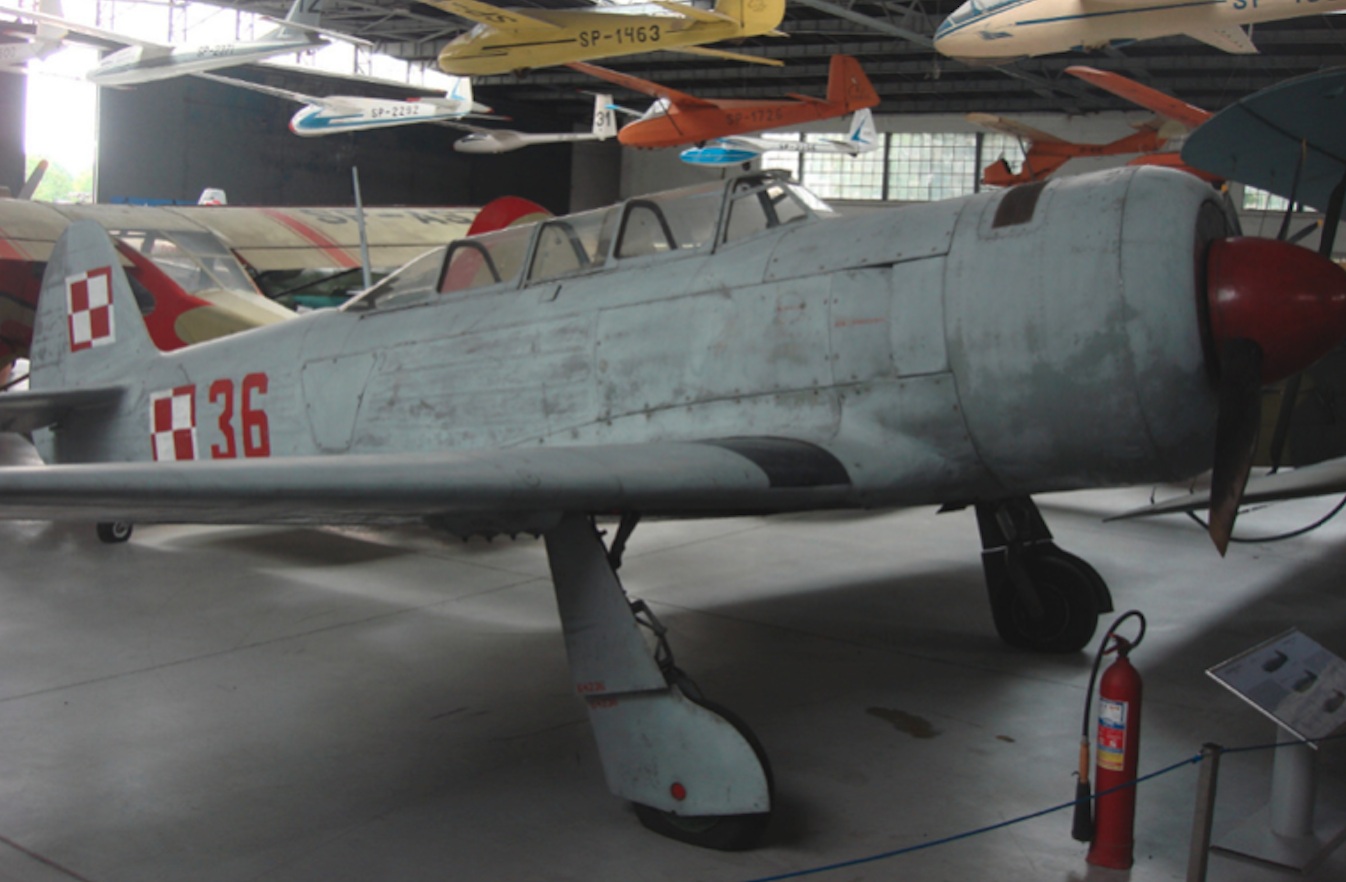Kraków 2008-01-03
7th Naval Assault Aviation Regiment (October 1944 – February 1946).
30th Naval Aviation Regiment.
7th Fighter-Assault (Fighter-Bomber) Regiment, Polish Navy.
7th Special Aviation Regiment, Polish Navy. 1950 – 1995.
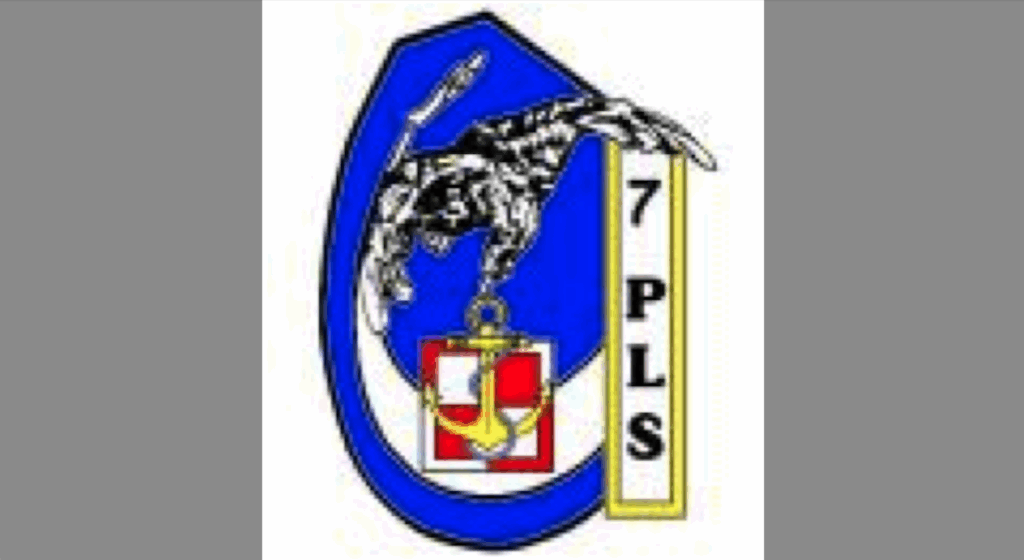
7th Assault Aviation Regiment. 1944–1946.
In October 1944, the Soviet 382nd Assault Aviation Regiment was incorporated into the Polish Front Aviation. The unit was renamed the 7th Assault Aviation Regiment and subordinated to the commander of the 2nd Assault Aviation Division. The Regiment was stationed in Szypovatoye near Volchansk, within the CCCP.
Only after replenishing its fleet of vehicles and training some of its Polish personnel, in March 1945, was the decision made to redeploy the Regiment to Poland. A portion of the Regiment, commanded by the Regiment Commander, Major Postojow, deviated from its course during redeployment in difficult weather conditions and landed at the Bakhmach airfield. They joined the rest of the Regiment only after the end of hostilities.
On April 20, 1945, the Regiment relocated from the vicinity of Tomaszów Mazowiecki to Lublinek airfield in Łódź, and on April 24, 1945, to a front-line airfield near Białęgi. On April 25, 26, 29, 1945, and on May 1, 1945, the Regiment, commanded by Captain Petrishchev, participated in military operations and completed 90 combat missions. On April 30, 1945, the Regiment was relocated to Steinbeck Airfield, and on May 1, 1945, after completing combat missions, it received orders to relocate to Ujazd Airfield near Tomaszów Mazowiecki, meaning to return to Poland. In May 1945, the Regiment had 30 Il-2 attack aircraft. In February 1946, the 7th Attack Aviation Regiment was disbanded by Order No. 019/Org. of the Commander of the Polish Army Aviation, dated January 22, 1946. This order was for the reorganization and transition of Polish Army Aviation units to peacetime duties.
Rebirth of Naval Aviation. 1946–1949.
The rebirth of the Polish Naval Aviation was very slow. It was not until September 1, 1946, that the Naval Aviation Department was established. On December 17, 1946, the Navy received its first air force unit, based in Puck. However, it had no combat value. On February 28, 1948, the Navy established a squadron consisting of four flight units based on the Puck flight unit. On October 18, 1948, the Navy received another squadron, consisting of five flight units. This squadron became an independent Naval Aviation Squadron, based at the Wicko Morskie airfield. The squadron was equipped with aircraft; Pe-2 bombers, Il-2 attack aircraft, Uil-2 training and attack aircraft, and Po-2 liaison aircraft. In January 1949, Yak-9M fighter aircraft arrived, followed by Yak-9Ps some time later.
30th Naval Aviation Regiment. 1950-1967.
On March 25, 1950, the 30th Naval Aviation Regiment was formed as Military Unit No. 5576, with assignment No. 35/118. This was done pursuant to Order No. 0235/Org. of the Ministry of National Defense dated November 22, 1949, and Order No. 01/Org. of the Navy Commander dated January 12, 1951. The Independent Naval Aviation Squadron became the basis for the creation of the new Regiment. The regiment was based at two airfields: one in Wicko Morskie, with a fighter squadron and Yak-9 aircraft. The other at Słupsk airport, with headquarters and attack, bomber-reconnaissance, and liaison squadrons. Pe-2 and Tu-2 bomber-reconnaissance aircraft were stationed at Słupsk.
In 1950, the 30th Polish Navy received a banner funded by the community of Katowice. In November 1950, the fighter squadron was relocated to the Gdynia-Babie Doły airport. In May 1951, the remaining squadrons arrived at Babie Doły. However, by July 1951, some aircraft, primarily bombers, were also based at the Gdańsk-Wrzeszcz airport. This was pursuant to Order No. 041/Oper of the Navy Commander-in-Chief of April 13, 1951. During this time, the Regiment received Yak-11 training aircraft.
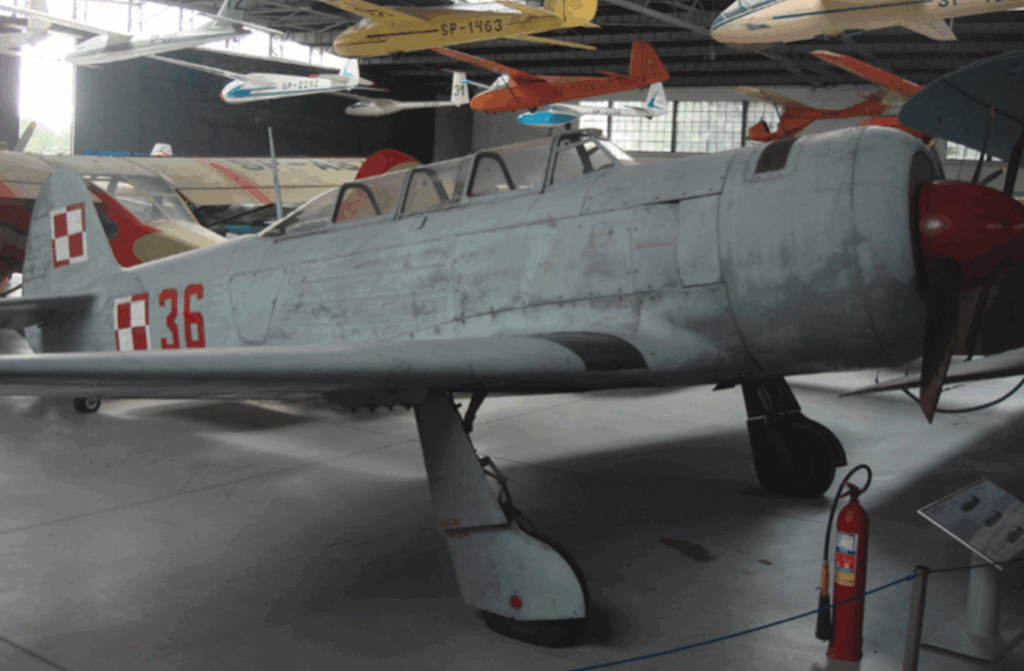
Further changes took place in 1951. In December 1951, on the basis of the Fighter Squadron, the 34th Fighter Aviation Regiment was formed as Military Unit No. 3651 according to station No. 6/100 pursuant to Order No. 095/Org. of the Ministry of National Defense of 10 December 1951 and Order No. 066/Org. of the Navy Commander of 31 December 1951. From 26 April 1954 to 10 August 1957, the Regiment was stationed at the Gdańsk-Wrzeszcz airport, and then at the airport in Siemirowice near Słupsk. In March 1956, the Naval Aviation adopted Il-28R bomber-reconnaissance aircraft. Therefore, on September 1, 1956, the 15th Special Naval Reconnaissance Squadron was formed on the basis of a squadron from the 30th Naval Aviation Regiment at Gdynia Babie Doły Airport. A month later (October 1956), it was transferred to the new airport in Siemirowice.
30th Naval Assault Aviation Regiment. 1957-1960.
On August 16, 1957, the unit (30th Naval Aviation Regiment) was reorganized and renamed the 30th Naval Assault Aviation Regiment. This was done in accordance with Order No. 0137/Org. of the Chief of the General Staff of the Polish Armed Forces, dated July 27, 1957, and the Order of the Commander of the Navy, dated August 16, 1957. Consequently, in August 1957, the first Lim-2 fighter-attack aircraft began to arrive at the Regiment, and the Regiment began to be based at the Siemirowice airfield, together with the 15th ESLR Navy. At that time, the Regiment primarily operated Lim-2 and Yak-11 aircraft.
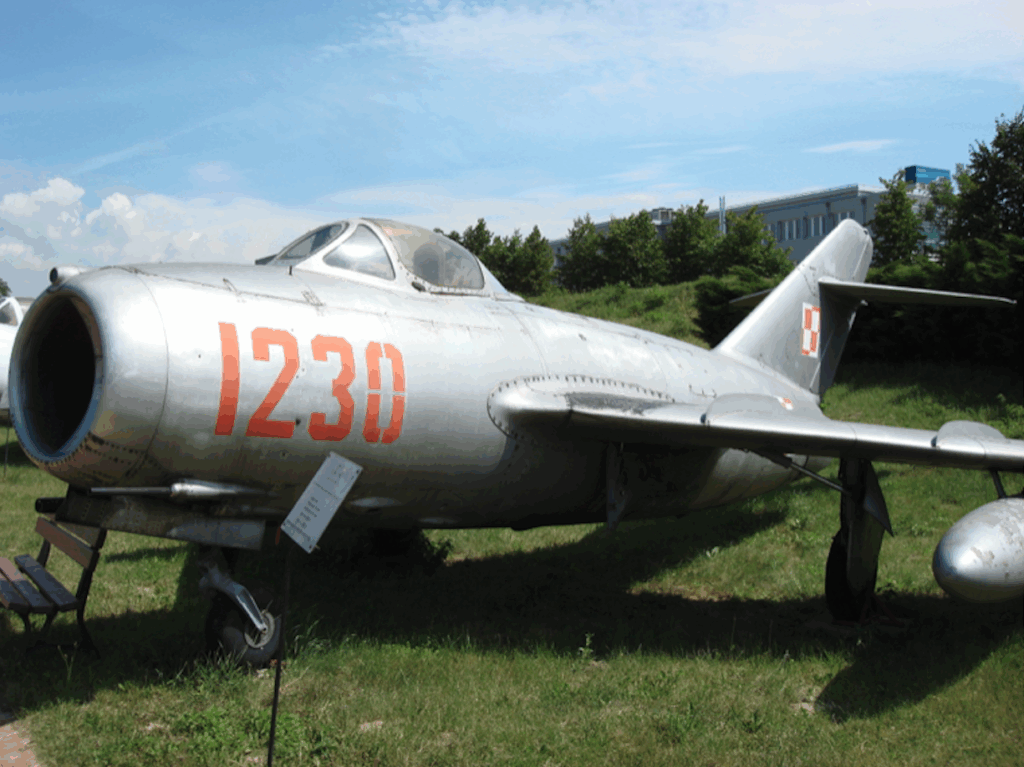
30th Fighter-Attack Aviation Regiment. 1960–1967.
In December 1960, the unit was renamed the 30th Attack Aviation Regiment to the 30th Fighter-Attack Aviation Regiment. In 1960, the first Polish-made Lim-5M attack aircraft were introduced. However, due to design flaws, the regiments operating these aircraft experienced several breakdowns and crashes. The aircraft were put into service with significant limitations, and after a few months, they were returned to Mielec for modernization. In February 1963, the first Polish-made TS-8 trainer aircraft were delivered to the Regiment. These aircraft significantly improved the training process for young pilots in the unit and allowed experienced pilots to consolidate their acquired skills.
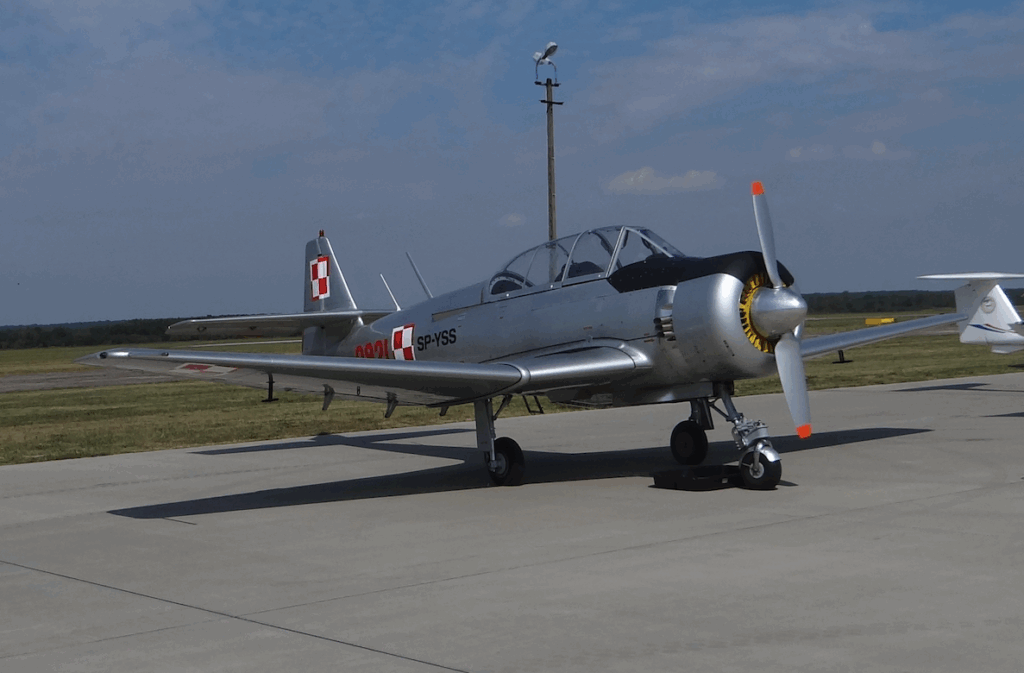
In January 1964, the Regiment received its first modern Polish-made Lim-6 bis attack aircraft. List of known aircraft delivered to the 30th Polish Air Force Regiment.
List of known Lim-6 bis aircraft delivered to the 30th Polish Air Force Regiment. Prepared by Karol Placha Hetman
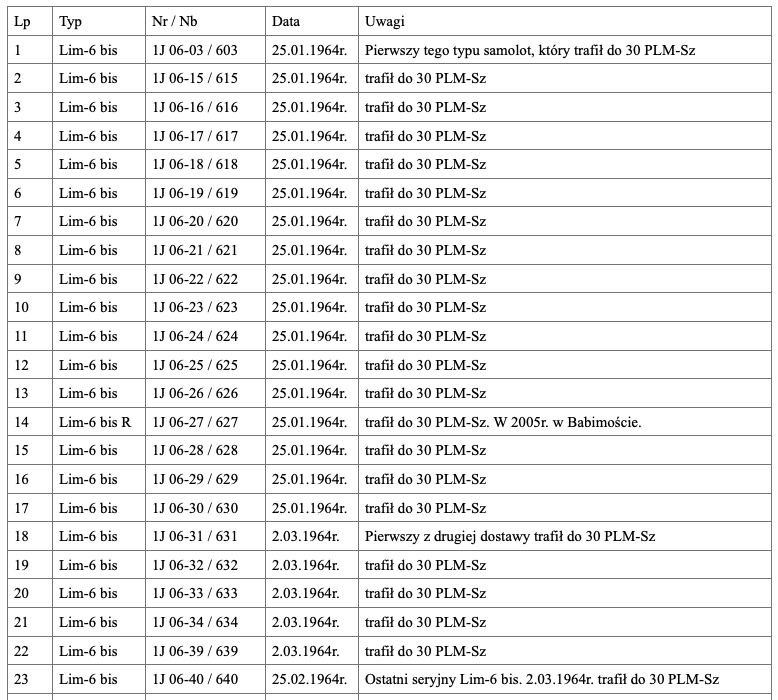
In January 1965, the Regiment also received its first multi-role aircraft, the PZL An-2, previously used by the 18th Liaison Aviation Squadron in Gdynia Babie Doły. In October 1966, the Regiment received its first MiG-15 UTI fighters. Specifically, these aircraft were assigned to the 15th Independent Naval Reconnaissance Aviation Squadron in Gdynia Babie Doły.
7th Naval Fighter-Attack Aviation Regiment. 1967–1983.
In 1967, the Regiment was renamed the 7th Naval Fighter-Attack Aviation Regiment (1967–1983). In May 1967, the unit assumed the heritage and traditions of the 7th Naval Fighter-Attack Aviation Regiment and the number and name of the 7th Polish Air Force Regiment. This was accomplished by Order No. 07/MON of May 4, 1967, on the transfer of historical names and numbers of front-line units to military units and the establishment of annual unit holidays (Journal of Laws of the Ministry of National Defense No. 5, item 21).
In April 1977, training on TS-8 aircraft was completed, and in May 1977, the first TS-11 Iskra trainer aircraft arrived.
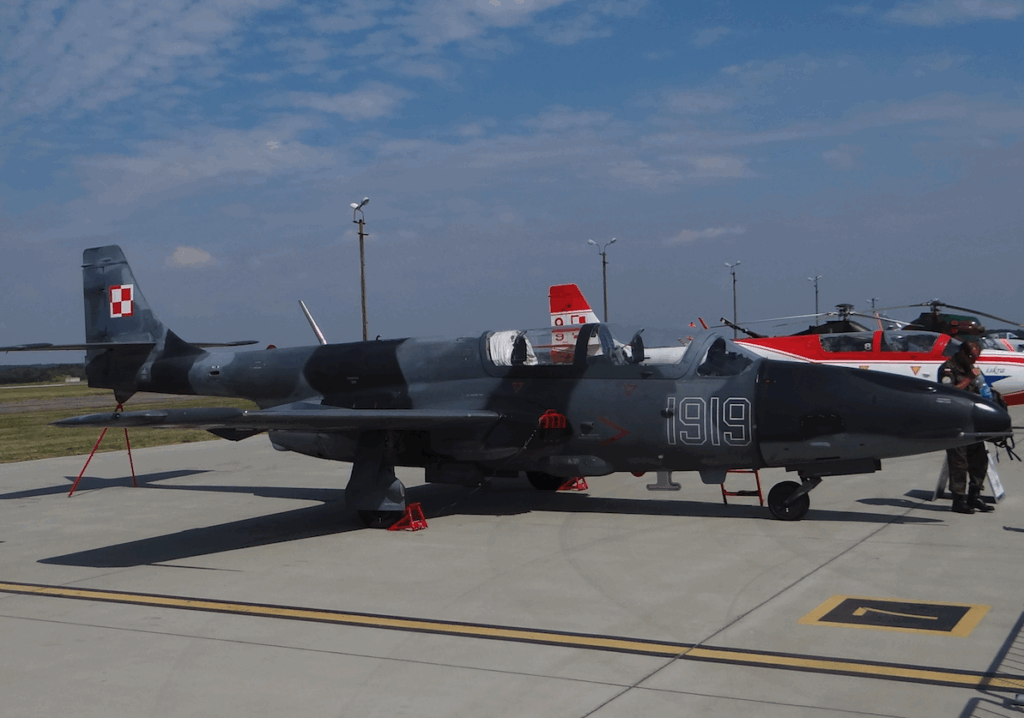
On October 1, 1979, the Il-28 took off for its final flight. This was also the last flight of this type in the Polish Army. The flight’s destination was the Nadarzyce training ground, where the aircraft served as a ground target.
On June 15, 1982, the last PZL Lim-2 aircraft were withdrawn from service in the Naval Aviation.
7th Naval Fighter-Bomber Regiment. 1983–1988.
In 1983, the Regiment was renamed the 7th Naval Fighter-Bomber Regiment (1983–1988). On February 15, 1983, the Regiment became a fighter-bomber unit. This was due to plans to equip the unit with new equipment. The basis for this was a November 1982 Order of the Chief of the General Staff. At the same time, on December 1, 1983, the 28th Naval Rescue Squadron, stationed in Darłowo, was reorganized into the 16th Naval Special Aviation Regiment. At that time, the 7th PLM-B had 36 Lim-6 bis, 8 Lim-2 SB, and 5 TS-11 Iskra aircraft. The 15th SELR had 10 Lim-2 A SB, and 2 Lim-2 SB aircraft.
7th Naval Special Aviation Regiment. 1988–1995.
In 1988, the Regiment was redesignated the 7th Naval Special Aviation Regiment (1988–1995). In 1988, significant reforms took place in the Naval Aviation. On July 1, 1988, the 7th Fighter-Bomber Regiment, the 16th Special Aviation Regiment, and the 15th Independent Reconnaissance Aviation Squadron were disbanded. Based on these units, a new 7th Naval Special Aviation Regiment was formed. The units were based at two airfields: Siemirowice and Darłowo. Also in 1988, the operation of the Lim-6 bis aircraft was officially discontinued. However, this was not the end of the transformation. On April 1, 1991, the units stationed in Darłowo formed a separate unit: the 40th Anti-Submarine and Rescue Squadron. In March 1991, the last SB Lim-2A aircraft were withdrawn from service, and TS-11 Iskra R aircraft were introduced. On October 25, 1994, the first PZL An-28 aircraft, designed for patrol and reconnaissance flights, was ceremonially handed over to the Regiment at the PZL Mielec plant. Specifically, it was a PZL M-28 B 1 R Bryza.
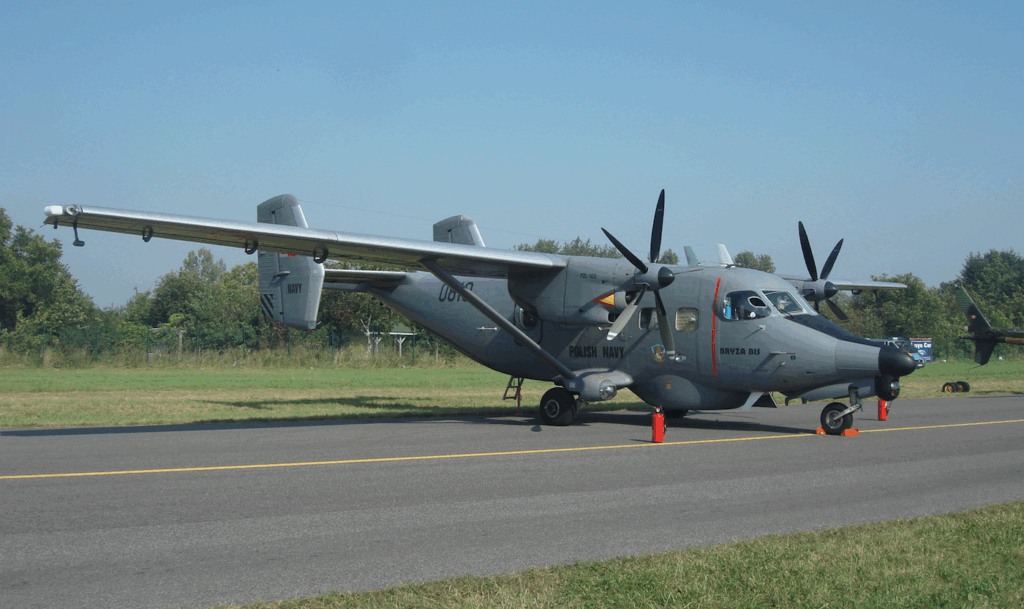
3rd Air Squadron. 1995.
The years 1994–1995 were a period of restructuring of the Navy’s aviation structure. Three Navy Air Squadrons were formed from existing units: the 1st Puck Air Division – Navy in Babie Doły (mainly with MiG-21 bis fighters), the 2nd Air Division – Navy in Darłowo (mainly with anti-submarine helicopters), and the 3rd Air Division – Navy in Siemirowice (with TS-11 R and M-28). On December 31, 1995, the Regiment was reorganized into the 3rd Air Squadron and the 5th Support Battalion, subordinated to the Commander of the Navy Aviation Brigade. The Squadron included the Reconnaissance Squadron with TS-11 Iskra R and TS-11 Iskra aircraft. The Patrol and Reconnaissance Squadron, with An-2 and M-28 Bryza aircraft, received new camouflage, new emblems, and white NAVY inscriptions.
On August 27, 1997, a ceremonial presentation of a banner donated by the Kashubian community took place. Simultaneously, by decision of the Minister of National Defense No. 155/MON of September 2, 1997, the Squadron was named “Kaszubski.” Navy Commander Admiral Ryszard Łukasik presented the banner to the Squadron Commander, Second Lieutenant Commander Mirosław Jankowski, a certified pilot. The banner was donated by the community of the Kashubian municipalities of Bytów and Sierakowice.
On October 12, 1996, the 5th Support Battalion received a new banner.
The 3rd Squadron was an independent combat unit of the Navy, designated for: Conducting operational and tactical reconnaissance of surface targets. Guiding detected Navy strike forces to targets. Performing transport and liaison tasks. Performing rescue missions on land and at sea. On July 1, 1997, the 3rd Kashubian Air Squadron of the Navy consisted of: 6 TS-11R Iskra bis DF, 8 TS-11 Iskra bis DF, 2 An-28 RM redesignated M-28, and 5 PZL An-2.
Equipment used by the regiment:
Ilyushin Il-2, Ilyushin Il-10, Yakovlev Yak-9, Yakovlev Yak-11, Pe-2, Tupolev Tu-2, Po-2, Antonov An-2, PZL Lim-2, PZL Lim-6 bis, PZL SB Lim-2 A, PZL TS-8 Bies, TS-11 Iskra bis / R, PZL Mielec M-28 ( An-28 ).
Written by Karol Placha Hetman

